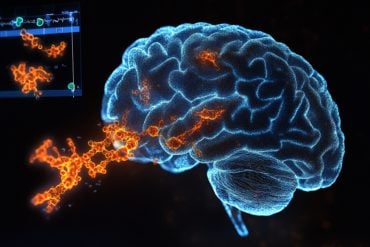Summary: A new method determines, with 91% accuracy whether a person is suffering from anxious or non-anxious depression from brain signals while the eyes are closed.
Source: University of Surrey
A new method of detecting anxious and non-anxious depression using brain signal processing has been developed by biomedical engineers at the University of Surrey.
The study results were shown to be roughly 91% accurate when patients had their brain activity monitored with their eyes closed.
Hesam Shakouh Alaei, lead author of the study from the University of Surrey, said:
“Patients with anxious depression often have more severe symptoms and side effects with a higher resistance to treatment than patients with non-anxious depression. This is why it is critical to distinguish these two cohorts from each other
“The hope is that these insights will help health professionals recognize anxious and non-anxious depression, and to treat accordingly.”
Anxious depression is when someone exhibits a combination of severe symptoms of both depression and anxiety. It is critically important to diagnose and treat anxious depression quickly to mitigate the negative impact of the condition.

The research team recorded a five-minute resting electroencephalogram (EEG) in 15 patients with anxious depression and nine patients with non-anxious depression under eyes open and closed conditions.
Researchers estimated the electrical activity of 68 subcortical regions using a neuroimaging technique called exact low-resolution brain electromagnetic tomography (eLORETA), and the information flow within the brain regions were measured by a directed connectivity measure. The obtained brain network of patients with anxious depression and non-anxious depression was then classified by machine learning.
The findings showed how patients with anxious depression broadcast stronger connectivity in the right hemisphere with accuracy improving significantly with eyes closed.
About this depression research news
Author: Katherine Ingram
Source: University of Surrey
Contact: Katherine Ingram – University of Surrey
Image: The image is in the public domain
Original Research: Closed access.
“Directed brain network analysis in anxious and non-anxious depression based on EEG source reconstruction and graph theory” by Hesam Shakouh Alaei. Biomedical Signal Processing and Control
Abstract
Directed brain network analysis in anxious and non-anxious depression based on EEG source reconstruction and graph theory
Patients with anxious depression have more severe symptoms, more side effects, and higher resistance to treatment than patients with non-anxious depression; therefore, it is crucial to clarify the differences between these two types of patients.
In this study, a 5-minute resting EEG was recorded in 15 patients with anxious depression and 9 patients with non-anxious depression under eyes open and closed conditions. Sixty-eight subcortical regions were extracted using exact low resolution brain electromagnetic tomography (eLORETA).
The directed transfer function was then used to construct brain networks. Specific features based on graph theory including the strength of connectivity and betweenness centrality (BC) were calculated from the networks.
Finally, significant features were selected using the Mann-Whitney U test, and patients were classified into anxious and non-anxious depressive groups using the Support Vector Machine (SVM).
Results showed that features of outward connectivity strength led to the highest accuracy, F-score, and specificity with 91.66%, 87. 5%, and 100% in the eyes-closed state, respectively. Moreover, we found that the strength of connectivity in both directions increased for the anxious depressive group during the eyes-open state. In particular, higher outward connectivity was observed in the right hemisphere for the anxious depressive group.
Further findings also revealed that features with the most significant difference were mainly associated with the beta band. In addition, significant increased inward and outward connectivity and decreased nodal centrality were observed in the posterior regions of the default mode network.
These preliminary findings might provide new insights into the recognition of anxious depressed patients.







